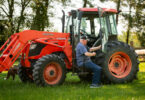Athens, Ga. – Blueberries are becoming big business in Georgia. University of Georgia experts plan to use a $1.7 million U.S. Department of Agriculture Specialty Crop Research Initiative grant to lead an effort to make the Southeast the leading producer of the fruit.
The U.S. has 75,000 acres of cultivated blueberries. A third of that is grown in the South. The region is on track to become the hub of U.S. blueberry production within the next five years, said Harald Scherm, a plant pathologist with the UGA College of Agricultural and Environmental Sciences.
A spring freeze severely damaged Georgia’s blueberry crop in 2007. But the 2006 crop was worth $75.8 million. The berry has the potential to add millions of dollars more to rural economies, said Gerard Krewer, a UGA Cooperative Extension fruit crop horticulturalist.
“Blueberries are grown in rural areas, areas that really need economic boosting,” Krewer said. “Blueberries are becoming a major horticultural commodity in southeast Georgia.”
Scherm will lead a team that includes Krewer and CAES horticulturists Dan MacLean and Anish Malladi, plant pathologist Phil Brannen, food scientist Rob Shewfelt and engineer Changying Li. The team will collaborate with colleagues in Florida, North Carolina, West Virginia and Mississippi.
The grant will be used to develop a way to harvest the berries mechanically while not damaging or dropping a majority of the fruit. The research team will also use the grant funds to genetically improve fruit quality and to fight diseases that are just starting to plague blueberry bushes.
Georgia producers predominately grow two types of blueberries – rabbiteye and southern highbush.
Rabbiteye – the variety traditionally grown in Georgia – has a thicker skin and is generally harvested in June and July. The development of the southern highbush variety allows growers to start harvesting blueberries in April and May, a period when berries are in short supply and prices are much higher.
But with the extra profits came new problems. The southern highbush has thin skin and bruises easily. Because of this, most are currently harvested by hand. Competition for farm workers and tighter immigration restrictions could cause the cost of harvesting to skyrocket for the crop in coming years. Hand-harvesting now cost farmers as much as 70 cents per pound.
Farmers now need machines that better harvest their crop. Current harvesting machinery drops too many blueberries – as much as 25 percent of the crop and can bruise delicate berries. Damaged berries are only good for the frozen market, and producers get much lower prices for frozen berries than they do for fresh.
Besides coming up with a better harvesting method, another way to deal with the thin skins of southern highbush is to breed new varieties with thicker skins, or with a crispy flesh.
Crispy flesh varieties are currently being developed by university breeding programs in Florida, North Carolina and Georgia. After narrowing down the varieties, UGA food scientists will use taste panels to determine which type of new southern highbush blueberry consumers would most likely buy.
“With so much blueberry acreage going in the last few years, there’s not been enough new plants to go around,” Scherm said.
New plants are propagated through cuttings, and he thinks this may help spread debilitating diseases not seen before. These diseases include blueberry red ringspot virus, bacterial leaf scorch and Botryosphaeria stem blight. Leaf scorch and stem blight have killed many southern highbush blueberry plantings in recent years.
Bacterial leaf scorch was first documented in 2006. Very little is known about how to control it. Scherm hopes to find answers to these questions primarily by studying disease epidemiology, transmission modes and cultivar resistance.






